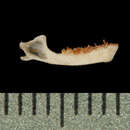pms
nòm ant ël fil


Vocalization from infants occurred for precursor for echolocation calls and as isolation calls (i-calls) to attract the mother. As the infants grew older the 2 calls increased. Female directive calls are different than their infants calls by having lower frequency and longer duration.
Lesser bamboo bats also use their vision, sense of smell, and sense of touch to perceive their environment and to communicate effectively among individuals.
Communication Channels: tactile ; acoustic ; chemical
Perception Channels: visual ; tactile ; ultrasound ; echolocation ; chemical
Lesser bamboo rats are considered lower risk/least concern by the IUCN. Populations seem stable currently.
US Federal List: no special status
CITES: no special status
State of Michigan List: no special status
IUCN Red List of Threatened Species: least concern
There are no known adverse effects of T. pachypus on humans.
Humans benefit from T. pachypus through their control of insect populations. They can eat thousands of insects a night.
Positive Impacts: controls pest population
Lesser bamboo bats keep insect pest populations down by eating thousands of them each night. Some of these insects are considered pests because they will destroy agricultural fields. Bamboo Gigantochloa scortechinii is used for roosting. Basilia hispida, a bat fly, is an ectoparasite of T. pachypus.
Species Used as Host:
Commensal/Parasitic Species:
Lesser bamboo bats are strictly insectivorous. The diet consists primarily of 7 different orders of insects. Hymenoptera, Diptera, Coleoptera, and Hemiptera are the 4 main orders, making up 62.3 %, 29.6 %, 6.0%, and 1.5%, respectively, of their diets. Other insects eaten include Homoptera, Blattodea, and Embioptera. Swarming termites, Isoptera, are also a small portion of their diet. Seasonal variation from spring to autumn occurs in their diet, no order of insects made up more than 50% of the total diet from March to April. From May to October, Hymenoptera made up more than 50% of the diet by volume.
Animal Foods: insects
Primary Diet: carnivore (Insectivore )
Lesser bamboo bats, Tylonycteris pachypus, are found in Bangladesh, India, Myanmar, South China, Thailand, Laos, Cambodia, Vietnam to peninsular Malaysia, the Philippines, Sumatra, Java, Borneo, Bali (Indonesia) and the Andaman Islands (India).
Biogeographic Regions: oriental (Native )
Lesser bamboo bats occupy lowland agricultural areas that contain bamboo stands. In a study done by Zhang et al. (2006), lesser bamboo bats were observed in three habitat types: along trees and houses, pathways along bamboo forest, and above bamboo forest. Of 145 individuals caught over a 28 day period, 45 % were collected on the pathway, 52 % were collected along the trees and houses and 3 % were collected above the bamboo forest.
Range elevation: 180 to 1220 m.
Habitat Regions: tropical ; terrestrial
Terrestrial Biomes: forest
Other Habitat Features: agricultural
The lifespan of T. pachypus is not reported. Like other vespertilionids, they may have relatively long lifespans, given their body size.
Lesser bamboo bats are small bats with well developed tails that are completely enclosed in a tail membrane.
Range mass: 2 to 5.8 g.
Range length: 35 to 50 mm.
Range wingspan: 25 to 33 mm.
Range basal metabolic rate: high (high) cm3.O2/g/hr.
Other Physical Features: endothermic ; heterothermic ; bilateral symmetry
Sexual Dimorphism: sexes alike
Predation on these bats is rare, but they have been known to be preyed on by owls when foraging at night.
Known Predators:
Anti-predator Adaptations: cryptic
Mating systems in lesser bamboo bats are not known, although polygyny is suspected based on some observed roosting patterns.
Mating System: polygynous
Mating seems to be seasonal, with males being fertile from mid-October to mid-January and females are in estrous from mid-October to mid-November. One offspring is usually born, sometimes two. Gestation is from 12 to 13 weeks long and the young are nursed for 5 to 6 weeks after that. The young are independent immediately after weaning and can breed in the first year after their birth.
Breeding interval: Lesser bamboo bats breed once each year.
Breeding season: Breeding season takes place from mid-October until mid-November.
Range number of offspring: 1 to 2.
Average number of offspring: 2.
Range gestation period: 84 to 91 days.
Range weaning age: 35 to 42 days.
Range time to independence: 5 to 6 weeks.
Range age at sexual or reproductive maturity (female): 8 to 9 months.
Range age at sexual or reproductive maturity (male): 8 to 9 months.
Key Reproductive Features: iteroparous ; seasonal breeding ; gonochoric/gonochoristic/dioecious (sexes separate); sexual ; viviparous
Mothers care for their young on their own. Because they roost in groups, they need efficient and distinctive communication calls to ensure successful reunions. In T. pachypus, recognition between the mother and pup is mutual. Recognition involves visual, acoustic and olfactory cues. Vocal signals that mediate recognition can be the mother’s echolocation calls, isolation calls from the infant, or other communication calls from the mother or infant. Infant bats often emit distinctive isolation calls (i-calls) which assist the location of offspring by the mother.
Parental Investment: altricial ; pre-fertilization (Provisioning, Protecting: Female); pre-hatching/birth (Provisioning: Female, Protecting: Female); pre-weaning/fledging (Provisioning: Female)